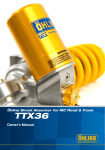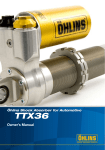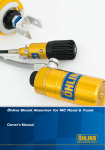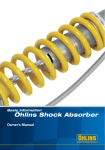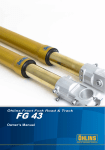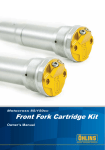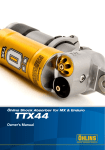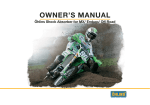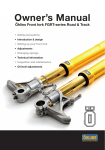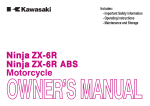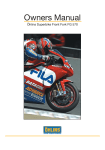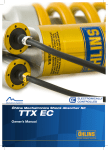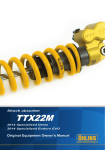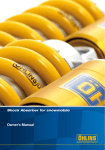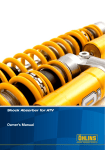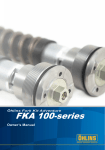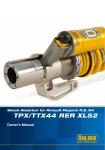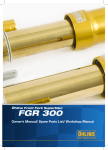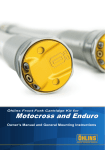Download 07242-01 OM TTX36.indd
Transcript
Owners Manual Ö hl i n s Sh o c k A b s o r b er T T X3 6 Öhlins Racing AB - The Story Öhlins Racing was established in 1976, and just two years later the company won its first World Championship title. Despite being in the business for 30 years, the search for perfection and new functions is still the main focus of the company. It was the 1970’s, a young man named Kenth Öhlin spent most of his spare time pursuing his favourite sport: motocross. A careful observer, Kenth’s attention was continually drawn to one specific detail - motocross bikes had more engine power than their suspension could handle. It was not long before Kenth realised that better performance could be achieved by improved wheel suspension. Congratulations! The product that you now have in your possession is pure racing breed that is built to withstand. By installing this shock absorber on your bike you have made a clear statement… you are a serious rider with a focus on getting the maximal handling ability and outstanding feedback from your bike. Along comes the fact that your shock absorber will be a long lasting friend, delivering the very best of comfort and performance every time you go for a ride. You are now the owner of an Öhlins Shock Absorber. More than one hundred World Championships and other major world titles are definitive proof that Öhlins shock absorbers offer outstanding performance and reliability. Every product has gone through rigorous testing and engineers have spent thousands of hours, doing their very best to use every possible experience from our 30 years within the racing sport. Go explore! 1 Safety Precautions Öhlins Racing AB cannot be held responsible for any damage to the shock absorber or vehicle, or injury to persons, if the instructions for installing and maintenance are not followed exactly. Similarly the warranty will become null and void if the instructions are not followed. ! 1. Safety Signals 2. In this manual, mounting instructions and other technical documents, important information concerning safety is distinguished by the following notations: ! 3. The Safety Alert Symbol means: Warning! Your safety is involved. WARNING! Installing a shock absorber, that is not approved by the vehicle manufacturer, may affect the stability of your vehicle. Öhlins Racing AB cannot be held responsible for any personal injury or damage that may occur after installing the shock absorber. Please study and make certain that you fully understand this manual and the mounting instructions before handling this shock absorber. If you have any questions regarding proper installation procedures or maintenance, please contact an Öhlins dealer. Refer to the vehicle service manual when installing this shock absorber. NOTE! ! Öhlins products are subject to continuous improvement and development. Therefore, although these instructions include the most up-to-date information available at the time of printing, there may be minor differences between your shock absorber and this manual. Please consult your Öhlins dealer if you have any questions regarding the contents of the manual. WARNING! The Warning Symbol means: Failure to follow warning instructions can result in severe or fatal injury to anyone working with, inspecting or using the shock absorber, or to bystanders. CAUTION! The Caution Symbol means: Special precautions must be taken to avoid damage to the shock absorber. Before riding the vehicle, always make sure that the basic settings made by Öhlins are correct. See the Mounting instructions for recommended Set-up data. Contact an Öhlins dealer if you have any questions about setting the shock absorber. NOTE! The Note Symbol indicates information that is of importance regarding procedures. © Öhlins Racing AB. All rights reserved. Any reprinting or unauthorized use without the written permission of Öhlins Racing AB is prohibited. Printed in Sweden. 2 C OM P RE B In This Manual Design and Function Spring Pre-load Compression and Rebound Length Adjustment and Set up Inspection and Maintenance 3 4 6 7 8 9 13 Design and Function Congratulations on choosing the Öhlins TTX Road & Track shock absorber - the most unique and powerful racing shock absorber available today. The TTX36 shock absorber design is the culmination of two decades of Öhlins successful participation in World Championship events. This shock absorber draws on all the expertise developed by Öhlins while winning more than one hundred World Championship titles. The TTX36 shock absorber is designed to handle the demanding damping characteristics needed for all types of tracks, from winding TT road race course to pure GP Road Racing tracks. The Öhlins TTX36 features a patented concept with a unique concentric twin tube design, together with a solid main piston, that allows for the gas pressure to always back-up the low-pressure side of the main piston. This design creates positive pressure build up on both compression and rebound stroke. As a result the TTX36 has a more direct damping response, less risk for cavitation and works with lower gas pressure. Compared to a regular piggy back single tube shock absorber, that has positive pressure build up only on rebound stroke and relies on compression valve resistance together with gas pressure to avoid cavitation on compression stroke, the TTX36 design is superior. Also the twin tube design with separate channels connecting the compression valve to the compression side of the main piston and the rebound valve to the rebound side of the main piston, gives the possibility to have completely separated adjusters for compression and rebound damping. The whole system is pressurized by nitrogen gas behind a floating piston to ensure separation of the gas and fluid. A top out spring is fitted in the TTX36 for optimum performance during hard braking. The Öhlins shim system offers infinite combinations of shim stacks with a wide spectrum of different character. Also different bleed valves are available. The Öhlins TTX36 shock absorber is a user friendly shock absorber with hydraulic main spring pre-load adjustment, length adjustment, easy to set up, dial in and rebuild. Support is always available from the Öhlins distributors worldwide. Function 4 When the shock absorber moves, the fluid inside is forced to flow through either the compression valve or rebound valve first (depending on direction of movement) ; followed by going through either the rebound check valve or compression check valve and on to the other side of the main piston (Fig. 2 and 3). The fluid displaced by the piston rod is directed either into or out of the reservoir. The reservoir is connected to the system so, regardless of direction of movement, it will be in contact with the low pressure side of the main piston. The compression and the rebound valve are both of the same design. The valve has three flow paths for the fluid. Bleed valve (Fig. 1 centre black arrows): small orifice that creates a flow restriction simply by being small. Shim valve: (Fig. 1 outer black arrows) fluid pressure has to deflect thin steel washers (shims) to open up an orifice and allow fluid to flow through it. Check valve: a spring pre-loaded shim that opens easily, for return flow of fluid when the direction of movement of the shock absorber changes (Fig. 1 outer white arrows). The bleed valve and shim valve are used to build up damping force. At slow stroke speeds the percentage going through the bleed valve is higher and at fast strokes the shim valve takes care of most of the flow. The check valve, together with the bleed valve (since it can flow both directions), handle return flow. During compression stroke, the piston rod is entering the main body and the correspondingly displaced volume of damper fluid has to flow into the reservoir; the separating piston moves accordingly. 1 Rebound Damping When the spring forces the shock absorber to extend again (Fig. 3), the fluid below the piston is pressurized (more than the set gas pressure) and has to move. In a similar pattern the flow goes through the: • rebound adjuster bleed valve • rebound adjuster shim valve • channel connected to the reservoir • compression adjuster check valve ...and into the inner tube to the upper side of the main piston. The fluid that was displaced into the reservoir during compression stroke, is now pushed back into the main body by the pressure of the gas; the separating piston moves accordingly. To control damping force the bleed valve can be changed in size by the external adjuster, compression and rebound. By altering the stiffness of the shim stack (number, thickness, diameter and shape) on the shim valve the characteristics of the damping action can be changed. This should only be done by an authorized Öhlins service workshop. 2 3 Compression Damping When movement of the motorcycle causes compression of the shock absorber, (Fig. 2) the fluid above the main piston is pressurized (more than the set gas pressure) and goes through the: • compression adjuster bleed valve • compression adjuster shim valve • channel connected to the reservoir • rebound adjuster check valve ...and between the outer and inner tube to the under side of the main piston. 5 Spring Pre-load Spring Pre-load When adjusting the spring pre-load you move the spring seat. This will decrease or increase the initial spring force, which will lower or raise the motorcycle rear ride height. The spring pre-load is fundamental for the function of the suspension. If the preload is incorrectly set, any other adjustments will not help to get the intended performance from the suspension. MP CO B RE The spring pre-load is the difference between A and B; 1 A A B R OM EB P C B Free spring length Installed spring length Shock absorber fully extended 2 A - B = Spring Pre-load 2B How to Set the Spring Pre-load 1. Turn the Hydraulic Adjuster knob to set the spring pre-load. Turn clockwise to increase the pre-load and turn counter clockwise to decrease. 2A If your shock absorber is not equipped with a Hydraulic Adjuster; 2. Use a C-spanner and move the spring platform to the desired position (2A). 6 Compression and Rebound Damping Compression and Rebound Damping RE Compression damping controls the energy absorption when the shock absorber is being compressed, thus controls how easy the shock absorber compresses when the rear wheel is being loaded or hits a bump. Rebound damping controls the energy absorption when the shock absorber is being extended and controls how fast the shock absorber returns to its normal position after being compressed. Adjust compression and rebound damping by turning the knobs on top of the reservoir. The adjusters have a normal right hand thread. B C O MP C OM EB P To reset the adjuster: Turn the adjuster clockwise to fully closed position (position zero [0]). Then, turn counter clockwise to open, and count the clicks until you reach the recommended number of clicks. See recommended Set-up data in the Mounting Instructions for the shock absorber. R 1 CAUTION! Do not use force, delicate sealing surfaces can be damaged. How to Adjust Compression EB P C OM R 2 Adjust by turning the gold knob labelled “COMP” on the cylinder head (1). Or, use a 14 mm socket T-bar and turn the hexagon nut on the adjuster knob (2). Turn clockwise to increase damping, turn counter clockwise to decrease. How to Adjust Rebound CAUTION! Adjust by turning the black knob labelled “REB” on the cylinder head (1). Or, use a 14 mm socket T-bar and turn the hexagon nut on the adjuster knob (2). Turn clockwise to increase damping, turn counter clockwise to decrease. 7 Length Length Adjustment EB OM P C R By adjusting the length of the shock absorber the steering geometry as well as the chain force can be changed. A shorter shock absorber will result in a lower motorcycle. The fork angle as well as the trail will increase, and normally the chain force will be reduced with less antisquat as a result. A slight change of centre of gravity is another result of changing the length of the shock absorber. A longer shock absorber will result in a higher motorcycle. The fork angle and trail will decrease and normally the chain force will increase with more anti-squat as a result. A slight change of centre of gravity is another result of changing the length of the shock absorber. NOTE! On modern Hypersport and race bikes all length adjustment should be moderate. Also very small adjustments can make a big difference. How to Adjust the Length We advise to remove the shock absorber from the vehicle before adjusting the length. Use two 24 mm wrenches. Hold the upper nut with one hand and at the same time loosen the lock nut (lower nut). Turn the end eye/bracket to the desired length. One [1] turn is 1 mm of shock absorber length. Please make sure to measure the ride height before and after adjusting the length (see page 9). Tightening torque: ! ! ! WARNING! The adjustable end eye/bracket must not be threaded out more than that the groove is fully visible beneath the lock nut. This is maximum length. After adjusting, make sure that the lock nut is tightened. 40 Nm WARNING! Remember to lock the lock nut after adjusting the length. 8 Adjustment and Set up ! ! WARNING! Setting Spring Pre-load Rear mark Step 1 - Measure Spring pre-load is a crucial part of setting your motorcycle since it affects the height of the motorcycle and the fork angle. NOTE! These measures should be taken with the motorcycle on a flat surface. • • • • • • WARNING! Incorrect spring rate may result in a front geometry that is either too steep or too flat. This can result in a tendency of under or over steering, that could seriously affect the handling characteristics of the motorcycle. When delivered, the Öhlins shock absorber is dialed to the recommended settings for the specific brand and make of the motorcycle. Before riding, always ensure that the basic settings made by Öhlins have not been changed during delivery. Always make notes, adjust in small steps and make only one adjustment at a time. Arrange the motorcycle so that the wheels are off the ground and that the front and the rear suspensions are fully extended. For example, tilt the motorcycle on its side stand. You may need to apply force on the wheels to get the suspensions fully extended, so that the top out springs do not compress it. Mark with a piece of tape or similar, a point on the seat or rear frame, and another point at the bottom of the front fork outer tube. Measure the distance from the marked point in the rear to the wheel axle (R1). Measure the distance from the marked point in the front to the front wheel axle (F1). Apply load on the front and the rear suspensions and take the same measurements (R2, F2) Now, take the same measurements with a rider fully equipped on the motorcycle (R3, F3). 9 Front mark Front Fork Springs Recommendations: If no other recommendations are given in the Mounting Instructions follow the measures below: To optimize the stability and traction of your motorcycle the front fork must match the rear suspension. Öhlins Racing has a variety of front fork springs available for a large number of motorcycle models. The springs in combination with the Öhlins shock absorbers contribute to superior stability and traction. See the Öhlins Recommendation List by contacting your nearest Öhlins dealer or using our web site. Free sag (R1-R2), (F1-F2) Rear 5-15 mm Front 20-30 mm Ride height (R1-R3), (F1-F3) Rear 25-35 mm Front 30-40 mm NOTE! Always check on the Öhlins web site (www.ohlins.com) or with your Öhlins dealer/ distributor for latest information. ! Step 2 - Adjust spring pre-load • • If your measures differ significantly from the recommendations in the Mounting Instructions or the table above, adjust the spring pre-load. (See section Spring Pre-load in this manual). If the ride height still differs from the recommendations, you may need to change to softer/harder spring. Contact your Öhlins dealer for advice. FGK kits and Piston kits Öhlins Racing also produces complete Racing Cartridge Systems, for front forks, as well as piston kits to upgrade your front fork to a higher performance level. Prepare the Settings By adjusting the shock absorber and testing by trial and error you can learn how the different settings affect your motorcycle. Always begin your setting by taking a test ride with all adjustments at their recommended basic setting. Choose a short run of varying character, for example with long as well as sharp bends, hard as well as soft bumps. Stay on the same run and adjust only one setting at a time. Stability and Traction All motorcycles are designed with a suspension geometry that includes height and fork angle. The changing of components can affect this and it is therefore essential that both the front and the rear ends match each other. Changing to Öhlins suspension gives optimum performance only when both the front fork and the rear suspension interact properly. It is very important that the front and the rear loaded heights are within the specified values. ! WARNING! If there are no matching springs for your motorcycle model, use the original springs, however, they must be in good condition and not fatigued. ! 10 If the vehicle feels • hard • bumpy ...decrease rebound damping If the vehicle feels unstable • • loose bouncy • ...increase rebound damping Recommended Adjustment Range Rebound damping Rebound and compression damping: ±5 clicks from original (basic) setting. If you have got a good feeling for the bike with spring, pre-load and the ride height feels OK but the bike runs low and packs down under acceleration bumps, with lost line and/or lost comfort and traction, open the rebound adjuster two [2] clicks. If the bike is nervous and moving a lot or has a high feeling entering corners, close the rebound adjuster two [2] clicks. Fine tune one [1] click at the time. Test run and make the necessary adjustments. For original rebound setting see the Mounting Instructions for your shock absorber. When you setup your bike you need to do it together with the front fork and on all types of tracks that you want to optimize, there are no setups that will be 100% perfect on all tracks, compromises need to be made. Keep priority at: • safe feeling stability • comfort • This will allow you to ride safer and use less energy. 11 If the vehicle feels • harsh • hard • has bad grip ...decrease compression damping If the vehicle • feels unstable • feels soft • feels low • is bottoming ...increase compression damping Compression damping When you feel that you have achieved an improvement, go back to where you started and check once more. Note other relevant factors such as tires, temperature etc. Test run to make sure whether further fine adjustments should be made. If the bike feels soft, unstable, is using to much wheel travel and you have the perfect spring for you; close the compression adjuster two [2] clicks. This will control the wheel during acceleration more, plus, it will help ride height and falling through the stroke too quickly. If the bike feels high, has bad grip at throttle opening and feels unsmooth over small or medium bumps during acceleration; open the compression adjuster two [2] clicks. Test run and make necessary corrections. When you have sufficient feel of the motorcycle you can make further fine adjustments. It is feeling and experience that counts. 12 Inspection and Maintenance Preventive maintenance and regular inspection reduces the risk of functional disturbance. If there is any need for additional service, please contact an authorized Öhlins workshop. Clean under the bump rubber • Cleaning R OM EB P Never spray water directly into the adjuster knobs and/or the ball joints. 1 C CAUTION! 4 6 Inspection Points Clean the shock absorber externally with a soft detergent. Use compressed air. Be careful that all dirt is removed. Lift the bump rubber and clean the area below. Keep the shock absorber clean and spray it with oil (WD40, CRC 5-56 or equivalent) after washing. • Inspection 1. 2. 3. 4. 5. 6. Check ball joints for possible excessive play or stiction. Check the piston shaft for leakage and damage. Check the shock absorber body for external damage. Check the reservoir for external damage that can restrict the floating piston from moving freely. Check for excessive wear of rubber components. Check the attachment points of the shock absorber to the vehicle. 3 2 5 6 • Recommended Service Intervals 1 NOTE! The Öhlins shock absorber should only be filled with the Öhlins High Performance Shock Absorber Fluid, art. no. 01306-xx. Contact your Öhlins dealer for advice. Racing: every 10 hours of operation. Maximum 20 hours of operation without service and oil change. Regular street use: every 30 000 km • Disposal ! Discarded Öhlins products should be handed over to an authorized Öhlins workshop or distributor for proper disposal. WARNING! Never alter the gas pressure. Special purpose charging equipment and access to nitrogen is required. 13 Owner’s Manual 07242-01 TTX36 Issued 2007 01 15 Illustrations Tiina Harakka Carlsson Öhlins Racing AB Read more at www.ohlins.com Öhlins Racing AB Box 722 S 194 27 Upplands Väsby Sweden Phone +46 8 590 025 00 Fax +46 8 590 025 80
















